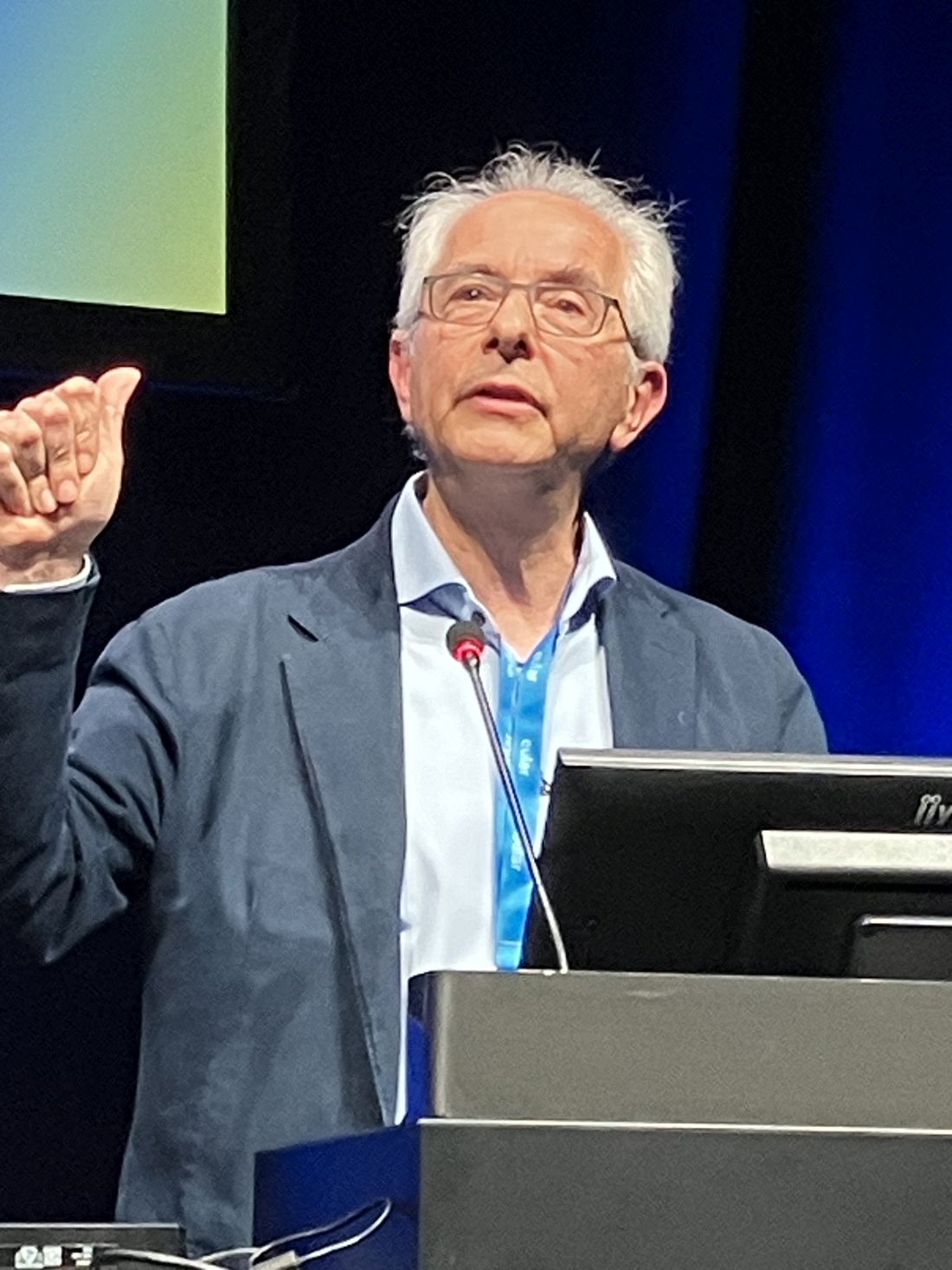User login
VIENNA — The hypothesis that pivotal clinical trials for osteoarthritis (OA)-modifying therapies are not using appropriate designs or endpoints appears to be consistent with the recent failure of the phase 3 trial of the investigational agent lorecivivint, according to experts tackling this issue.
For the elusive target of disease-modifying OA drugs (DMOADs), “there have been a lot of developments in the last few years but so far a lot of disappointments,” said Francis Berenbaum, MD, PhD, head of the department of rheumatology, Saint-Antoine Hospital, Paris, France.
Disagreement on the target most likely to favorably alter the natural history of disease might be the key issue. Dr. Berenbaum considers it essential to determine which changes in the joint signify a favorable drug effect and will lead to what regulatory agencies consider a clinically meaningful benefit. These include improved function and long-term preservation of the joint, as well as symptom control.
Of primary targets to modify the course of OA, cartilage is not one of them, according to Dr. Berenbaum, who spoke in a session on DMOADs and regenerative OA therapies at the annual European Congress of Rheumatology.
OA Is Not a Cartilage-Only Disease
“There is now a big consensus that osteoarthritis is not a cartilage-only disease,” he said. Rather, he addressed the inadequate appreciation of the “whole joint” pathology that underlies OA. He called for a fundamental “paradigm change” to work toward a disease-modifying effect that produces benefit on a hard endpoint.
There are multiple steps needed to work toward this goal after a consensus is reached on a meaningful surrogate endpoint, Dr. Berenbaum said. While symptom reduction is a good start, he called for evidence of disease attenuation or a regenerative effect on an important surrogate such as improved integrity of synovial tissue and improved bone health. Such surrogates are necessary to guide DMOAD development but not sufficient. The proof that a therapy is a DMOAD depends on a favorable effect on a hard endpoint. In the case of the knee, freedom from joint replacement is an example, Dr. Berenbaum said.
Philip G. Conaghan, MBBS, PhD, director of rheumatic and musculoskeletal medicine, University of Leeds, England, agreed with this general premise. Speaking just before Dr. Berenbaum in the same session, Dr. Conaghan traced this history of the effort to create DMOADs and updated those in clinical trials.
In his talk, he listed some of the many disappointments, including those which have targeted cartilage thickness, before updating the numerous ongoing development programs. There are many targets that appear viable, but none are in final stages of testing.
In remarks to this news organization, he said he generally agreed with Dr. Berenbaum about the need for greater rigor for developing drugs to meet regulatory criteria for disease-modifying effects.
Of the drugs he reviewed, Dr. Conaghan identified lorecivivint, an intra-articular CLK/DYRK inhibitor that’s thought to modulate Wnt and inflammatory pathways, as the only drug with DMOAD potential to go to a multicenter phase 3 trial so far. The drug’s negative outcome in phase 3 was particularly disappointing after the substantial promise shown in a phase 2b study published in 2021.
In the phase 3 study, lorecivivint, relative to placebo, did not achieve a significant improvement in the primary endpoint of improved medial joint space width (JSW) in the target knee as assessed at the end of a 48-week, double-blind trial.
New Follow-Up Data Support DMOAD Activity
Yet, additional extension data from the phase 3 lorecivivint trial presented in the EULAR DMOAD session challenge the conclusion even if they do not change the results.
The new data presented at EULAR is the second of two sets of extension data. The first, reported earlier, involved an analysis at 96 weeks or 48 weeks after the double-blind trial. At the beginning of this extension, lorecivivint-start patients had received a second intraarticular injection of 0.07 mg, while placebo patients were crossed over to receive their first injection.
Over the course of this first extension, the gradual loss in medial JSW observed from baseline to the end of the initial 48 weeks had plateaued in those treated with lorecivivint, but the decline continued in the placebo group. As a result, the lorecivivint-start patients had a numerical but not a statistically significant advantage for medial JSW over the placebo-switch group, according to Yusuf Yazici, MD, chief medical officer of Biosplice Therapeutics, San Diego, which developed lorecivivint.
In a second open-label extension described by Dr. Yazici at EULAR 2024, a third injection was administered to the lorecivivint-start patients and a second injection to the placebo-start patients. After 52 more weeks of follow-up, there were now 3 years of follow-up in the lorecivivint-start group and 2 years of follow-up in the placebo-start group.
At the end of this second extension, lorecivivint-start patients had a median increase in JSW that was approaching the baseline level at study entry. Although the placebo-start group had experienced a decline in the medial JSW at the end of the first extension when they had received one injection, JSW had also improved in the direction of baseline after a second injection with 2 years of follow-up. The advantage of three injections of lorecivivint over 3 years had now reached statistical significance (P = .031) despite the improvement seen in the placebo-start group following two injections over 2 years.
At 3 Years, Benefit Is Finally Potentially Significant
If placebo-treated patients had not received a second shot of lorecivivint and progressed at the rate seen before their second shot, the hypothetical trajectory would have provided lorecivivint with a highly statistically significant advantage (P < .001), said Dr. Yazici, displaying a hypothetical graph.
Along with improvements in pain and function associated with lorecivivint relative to placebo at 6 months, 12 months, and 24 months, the structural improvements in 3 years now suggest that “long-term treatment with lorecivivint has the potential to be a DMOAD for knee OA,” Dr. Yazici said.
While Dr. Berenbaum did not comment on this speculation, he did note the potential need for long-term studies to prove a disease-modifying effect in OA. This is the rationale for identifying surrogates.
To illustrate this point, Dr. Berenbaum made an analogy between OA and cardiovascular disease. In cardiovascular disease, surrogates of disease-modifying therapies, such as control of hypertension or hyperlipidemia, are accepted by regulatory agencies on the basis of their proven association with hard endpoints, such as myocardial infarction, stroke, or cardiovascular death. Like joint failure, these events can take years or decades to arise.
“For trials in OA, we need to agree on these surrogates,” Dr. Berenbaum said, although he acknowledged that they would then have to be validated. Noting that the US Food and Drug Administration has now identified OA as a serious disease for which accelerated drug approvals will be considered to address an unmet need, Dr. Berenbaum suggested there is an even greater impetus for improving strategies for DMOAD development.
Dr. Berenbaum reported financial relationships with Grünenthal, GlaxoSmithKline, Eli Lilly, Novartis, Pfizer, and Servier. Dr. Conaghan reported financial relationships with AbbVie, AstraZeneca, Eli Lilly, Galapagos, GlaxoSmithKline, Grünenthal, Janssen, Levicept, Merck, Novartis, Pfizer, Regeneron, Stryker, and UCB. Dr. Yazici is an employee of Biosplice Therapeutics, which provided funding for the OAS-07 trial.
A version of this article first appeared on Medscape.com.
VIENNA — The hypothesis that pivotal clinical trials for osteoarthritis (OA)-modifying therapies are not using appropriate designs or endpoints appears to be consistent with the recent failure of the phase 3 trial of the investigational agent lorecivivint, according to experts tackling this issue.
For the elusive target of disease-modifying OA drugs (DMOADs), “there have been a lot of developments in the last few years but so far a lot of disappointments,” said Francis Berenbaum, MD, PhD, head of the department of rheumatology, Saint-Antoine Hospital, Paris, France.
Disagreement on the target most likely to favorably alter the natural history of disease might be the key issue. Dr. Berenbaum considers it essential to determine which changes in the joint signify a favorable drug effect and will lead to what regulatory agencies consider a clinically meaningful benefit. These include improved function and long-term preservation of the joint, as well as symptom control.
Of primary targets to modify the course of OA, cartilage is not one of them, according to Dr. Berenbaum, who spoke in a session on DMOADs and regenerative OA therapies at the annual European Congress of Rheumatology.
OA Is Not a Cartilage-Only Disease
“There is now a big consensus that osteoarthritis is not a cartilage-only disease,” he said. Rather, he addressed the inadequate appreciation of the “whole joint” pathology that underlies OA. He called for a fundamental “paradigm change” to work toward a disease-modifying effect that produces benefit on a hard endpoint.
There are multiple steps needed to work toward this goal after a consensus is reached on a meaningful surrogate endpoint, Dr. Berenbaum said. While symptom reduction is a good start, he called for evidence of disease attenuation or a regenerative effect on an important surrogate such as improved integrity of synovial tissue and improved bone health. Such surrogates are necessary to guide DMOAD development but not sufficient. The proof that a therapy is a DMOAD depends on a favorable effect on a hard endpoint. In the case of the knee, freedom from joint replacement is an example, Dr. Berenbaum said.
Philip G. Conaghan, MBBS, PhD, director of rheumatic and musculoskeletal medicine, University of Leeds, England, agreed with this general premise. Speaking just before Dr. Berenbaum in the same session, Dr. Conaghan traced this history of the effort to create DMOADs and updated those in clinical trials.
In his talk, he listed some of the many disappointments, including those which have targeted cartilage thickness, before updating the numerous ongoing development programs. There are many targets that appear viable, but none are in final stages of testing.
In remarks to this news organization, he said he generally agreed with Dr. Berenbaum about the need for greater rigor for developing drugs to meet regulatory criteria for disease-modifying effects.
Of the drugs he reviewed, Dr. Conaghan identified lorecivivint, an intra-articular CLK/DYRK inhibitor that’s thought to modulate Wnt and inflammatory pathways, as the only drug with DMOAD potential to go to a multicenter phase 3 trial so far. The drug’s negative outcome in phase 3 was particularly disappointing after the substantial promise shown in a phase 2b study published in 2021.
In the phase 3 study, lorecivivint, relative to placebo, did not achieve a significant improvement in the primary endpoint of improved medial joint space width (JSW) in the target knee as assessed at the end of a 48-week, double-blind trial.
New Follow-Up Data Support DMOAD Activity
Yet, additional extension data from the phase 3 lorecivivint trial presented in the EULAR DMOAD session challenge the conclusion even if they do not change the results.
The new data presented at EULAR is the second of two sets of extension data. The first, reported earlier, involved an analysis at 96 weeks or 48 weeks after the double-blind trial. At the beginning of this extension, lorecivivint-start patients had received a second intraarticular injection of 0.07 mg, while placebo patients were crossed over to receive their first injection.
Over the course of this first extension, the gradual loss in medial JSW observed from baseline to the end of the initial 48 weeks had plateaued in those treated with lorecivivint, but the decline continued in the placebo group. As a result, the lorecivivint-start patients had a numerical but not a statistically significant advantage for medial JSW over the placebo-switch group, according to Yusuf Yazici, MD, chief medical officer of Biosplice Therapeutics, San Diego, which developed lorecivivint.
In a second open-label extension described by Dr. Yazici at EULAR 2024, a third injection was administered to the lorecivivint-start patients and a second injection to the placebo-start patients. After 52 more weeks of follow-up, there were now 3 years of follow-up in the lorecivivint-start group and 2 years of follow-up in the placebo-start group.
At the end of this second extension, lorecivivint-start patients had a median increase in JSW that was approaching the baseline level at study entry. Although the placebo-start group had experienced a decline in the medial JSW at the end of the first extension when they had received one injection, JSW had also improved in the direction of baseline after a second injection with 2 years of follow-up. The advantage of three injections of lorecivivint over 3 years had now reached statistical significance (P = .031) despite the improvement seen in the placebo-start group following two injections over 2 years.
At 3 Years, Benefit Is Finally Potentially Significant
If placebo-treated patients had not received a second shot of lorecivivint and progressed at the rate seen before their second shot, the hypothetical trajectory would have provided lorecivivint with a highly statistically significant advantage (P < .001), said Dr. Yazici, displaying a hypothetical graph.
Along with improvements in pain and function associated with lorecivivint relative to placebo at 6 months, 12 months, and 24 months, the structural improvements in 3 years now suggest that “long-term treatment with lorecivivint has the potential to be a DMOAD for knee OA,” Dr. Yazici said.
While Dr. Berenbaum did not comment on this speculation, he did note the potential need for long-term studies to prove a disease-modifying effect in OA. This is the rationale for identifying surrogates.
To illustrate this point, Dr. Berenbaum made an analogy between OA and cardiovascular disease. In cardiovascular disease, surrogates of disease-modifying therapies, such as control of hypertension or hyperlipidemia, are accepted by regulatory agencies on the basis of their proven association with hard endpoints, such as myocardial infarction, stroke, or cardiovascular death. Like joint failure, these events can take years or decades to arise.
“For trials in OA, we need to agree on these surrogates,” Dr. Berenbaum said, although he acknowledged that they would then have to be validated. Noting that the US Food and Drug Administration has now identified OA as a serious disease for which accelerated drug approvals will be considered to address an unmet need, Dr. Berenbaum suggested there is an even greater impetus for improving strategies for DMOAD development.
Dr. Berenbaum reported financial relationships with Grünenthal, GlaxoSmithKline, Eli Lilly, Novartis, Pfizer, and Servier. Dr. Conaghan reported financial relationships with AbbVie, AstraZeneca, Eli Lilly, Galapagos, GlaxoSmithKline, Grünenthal, Janssen, Levicept, Merck, Novartis, Pfizer, Regeneron, Stryker, and UCB. Dr. Yazici is an employee of Biosplice Therapeutics, which provided funding for the OAS-07 trial.
A version of this article first appeared on Medscape.com.
VIENNA — The hypothesis that pivotal clinical trials for osteoarthritis (OA)-modifying therapies are not using appropriate designs or endpoints appears to be consistent with the recent failure of the phase 3 trial of the investigational agent lorecivivint, according to experts tackling this issue.
For the elusive target of disease-modifying OA drugs (DMOADs), “there have been a lot of developments in the last few years but so far a lot of disappointments,” said Francis Berenbaum, MD, PhD, head of the department of rheumatology, Saint-Antoine Hospital, Paris, France.
Disagreement on the target most likely to favorably alter the natural history of disease might be the key issue. Dr. Berenbaum considers it essential to determine which changes in the joint signify a favorable drug effect and will lead to what regulatory agencies consider a clinically meaningful benefit. These include improved function and long-term preservation of the joint, as well as symptom control.
Of primary targets to modify the course of OA, cartilage is not one of them, according to Dr. Berenbaum, who spoke in a session on DMOADs and regenerative OA therapies at the annual European Congress of Rheumatology.
OA Is Not a Cartilage-Only Disease
“There is now a big consensus that osteoarthritis is not a cartilage-only disease,” he said. Rather, he addressed the inadequate appreciation of the “whole joint” pathology that underlies OA. He called for a fundamental “paradigm change” to work toward a disease-modifying effect that produces benefit on a hard endpoint.
There are multiple steps needed to work toward this goal after a consensus is reached on a meaningful surrogate endpoint, Dr. Berenbaum said. While symptom reduction is a good start, he called for evidence of disease attenuation or a regenerative effect on an important surrogate such as improved integrity of synovial tissue and improved bone health. Such surrogates are necessary to guide DMOAD development but not sufficient. The proof that a therapy is a DMOAD depends on a favorable effect on a hard endpoint. In the case of the knee, freedom from joint replacement is an example, Dr. Berenbaum said.
Philip G. Conaghan, MBBS, PhD, director of rheumatic and musculoskeletal medicine, University of Leeds, England, agreed with this general premise. Speaking just before Dr. Berenbaum in the same session, Dr. Conaghan traced this history of the effort to create DMOADs and updated those in clinical trials.
In his talk, he listed some of the many disappointments, including those which have targeted cartilage thickness, before updating the numerous ongoing development programs. There are many targets that appear viable, but none are in final stages of testing.
In remarks to this news organization, he said he generally agreed with Dr. Berenbaum about the need for greater rigor for developing drugs to meet regulatory criteria for disease-modifying effects.
Of the drugs he reviewed, Dr. Conaghan identified lorecivivint, an intra-articular CLK/DYRK inhibitor that’s thought to modulate Wnt and inflammatory pathways, as the only drug with DMOAD potential to go to a multicenter phase 3 trial so far. The drug’s negative outcome in phase 3 was particularly disappointing after the substantial promise shown in a phase 2b study published in 2021.
In the phase 3 study, lorecivivint, relative to placebo, did not achieve a significant improvement in the primary endpoint of improved medial joint space width (JSW) in the target knee as assessed at the end of a 48-week, double-blind trial.
New Follow-Up Data Support DMOAD Activity
Yet, additional extension data from the phase 3 lorecivivint trial presented in the EULAR DMOAD session challenge the conclusion even if they do not change the results.
The new data presented at EULAR is the second of two sets of extension data. The first, reported earlier, involved an analysis at 96 weeks or 48 weeks after the double-blind trial. At the beginning of this extension, lorecivivint-start patients had received a second intraarticular injection of 0.07 mg, while placebo patients were crossed over to receive their first injection.
Over the course of this first extension, the gradual loss in medial JSW observed from baseline to the end of the initial 48 weeks had plateaued in those treated with lorecivivint, but the decline continued in the placebo group. As a result, the lorecivivint-start patients had a numerical but not a statistically significant advantage for medial JSW over the placebo-switch group, according to Yusuf Yazici, MD, chief medical officer of Biosplice Therapeutics, San Diego, which developed lorecivivint.
In a second open-label extension described by Dr. Yazici at EULAR 2024, a third injection was administered to the lorecivivint-start patients and a second injection to the placebo-start patients. After 52 more weeks of follow-up, there were now 3 years of follow-up in the lorecivivint-start group and 2 years of follow-up in the placebo-start group.
At the end of this second extension, lorecivivint-start patients had a median increase in JSW that was approaching the baseline level at study entry. Although the placebo-start group had experienced a decline in the medial JSW at the end of the first extension when they had received one injection, JSW had also improved in the direction of baseline after a second injection with 2 years of follow-up. The advantage of three injections of lorecivivint over 3 years had now reached statistical significance (P = .031) despite the improvement seen in the placebo-start group following two injections over 2 years.
At 3 Years, Benefit Is Finally Potentially Significant
If placebo-treated patients had not received a second shot of lorecivivint and progressed at the rate seen before their second shot, the hypothetical trajectory would have provided lorecivivint with a highly statistically significant advantage (P < .001), said Dr. Yazici, displaying a hypothetical graph.
Along with improvements in pain and function associated with lorecivivint relative to placebo at 6 months, 12 months, and 24 months, the structural improvements in 3 years now suggest that “long-term treatment with lorecivivint has the potential to be a DMOAD for knee OA,” Dr. Yazici said.
While Dr. Berenbaum did not comment on this speculation, he did note the potential need for long-term studies to prove a disease-modifying effect in OA. This is the rationale for identifying surrogates.
To illustrate this point, Dr. Berenbaum made an analogy between OA and cardiovascular disease. In cardiovascular disease, surrogates of disease-modifying therapies, such as control of hypertension or hyperlipidemia, are accepted by regulatory agencies on the basis of their proven association with hard endpoints, such as myocardial infarction, stroke, or cardiovascular death. Like joint failure, these events can take years or decades to arise.
“For trials in OA, we need to agree on these surrogates,” Dr. Berenbaum said, although he acknowledged that they would then have to be validated. Noting that the US Food and Drug Administration has now identified OA as a serious disease for which accelerated drug approvals will be considered to address an unmet need, Dr. Berenbaum suggested there is an even greater impetus for improving strategies for DMOAD development.
Dr. Berenbaum reported financial relationships with Grünenthal, GlaxoSmithKline, Eli Lilly, Novartis, Pfizer, and Servier. Dr. Conaghan reported financial relationships with AbbVie, AstraZeneca, Eli Lilly, Galapagos, GlaxoSmithKline, Grünenthal, Janssen, Levicept, Merck, Novartis, Pfizer, Regeneron, Stryker, and UCB. Dr. Yazici is an employee of Biosplice Therapeutics, which provided funding for the OAS-07 trial.
A version of this article first appeared on Medscape.com.
FROM EULAR 2024



